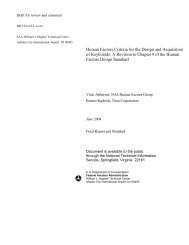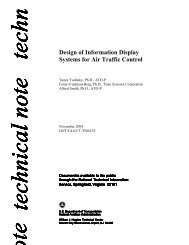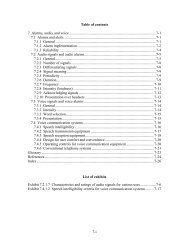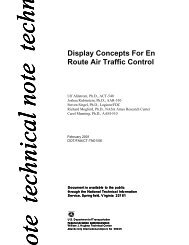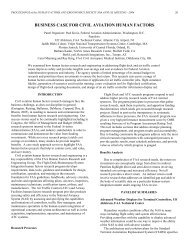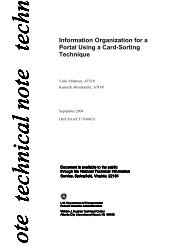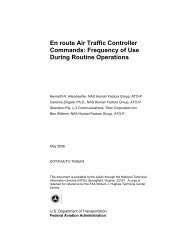Chapter 14. Anthropometry and Biomechanics - FAA
Chapter 14. Anthropometry and Biomechanics - FAA
Chapter 14. Anthropometry and Biomechanics - FAA
You also want an ePaper? Increase the reach of your titles
YUMPU automatically turns print PDFs into web optimized ePapers that Google loves.
HFDS 2003 (amended Oct 2009)<strong>Chapter</strong> 14 <strong>Anthropometry</strong> <strong>and</strong> biomechanics<strong>14.</strong>5.2 Exerted forces<strong>14.</strong>5.2.1 Maximum young male force or resistance for acontrol. The maximum amount of force or resistance designedinto a control should be determined by the greatest amount offorce that can be exerted by the weakest person likely to operatethe control. Control force limits, like most strength designlimits, should be based upon the 5th percentile (or, for criticaltasks, the 1st percentile) of the female user population. [Source:MIL-HDBK-759B, 1992; AFSC DH 1-3, 1980]Exhibit <strong>14.</strong>5.2.1 represents 80% of the maximum exertion forcesfor the 5th percentile male for the arm, h<strong>and</strong> <strong>and</strong> thumb. Sincethe experimental conditions used to collect the source datayielded maximum possible exertion values for young men, thesevalues are were too high for design purpose. For design, onedoes not want to deliberately or consistently require maximumexertions. Thus these source values were reduced by 20% bef oreapplying them as design criteria. Male data should be selectedbased upon the body components involved in the specificexertion task. To estimate female strength, male data should befurther reduced according to Paragraph <strong>14.</strong>5. 2.3. Females canapply most strength when torso, back, <strong>and</strong> legs are majorcontributors. Female upper body <strong>and</strong> arm strength are weakest(see also comparative lifting strength information Paragraph<strong>14.</strong>5.2.3).Discussion. The maximum force that can be applied willdepend on such factors as the type of control, the bodymember used to operate it, the position of this bodymember during control operations, the general position ofthe body, <strong>and</strong> whether or not support is provided bybackrests.14-43



